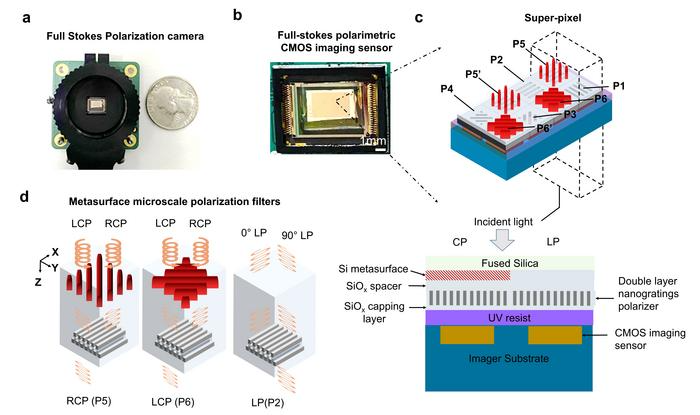
a, Image of full Stokes polarization camera beside a U.S. dollar coin (lens not attached). b Image of full Stokes polarimetric CMOS imaging sensor c Top: 3D Conceptual illustration of chip integrated full Stokes CMOS polarimetric imaging sensor. Here P1-P4 denotes the LP filters with transmission axes at 0°, 90°, 45°, and 135° respectively. P5, P5’ and P6, P6’ denote chiral metasurface filters transmitting right-handed circularly polarized (RCP) and left-handed circularly polarized (LCP), respectively. Here, P5 and P5’, P6 and P6’ are identical in dimensions respectively. bottom: 2D cross-section of the chip-integrated polarization imaging sensor. d 3D conceptual illustration of a pair of chiral metasurfaces responsible for transmitting RCP and LCP light, respectively (P5, P6) and an LP filter (P2). Image Credit: by Jiawei Zuo, Jing Bai, Shinhyuk Choi, Ali Basiri, Xiahui Chen, Chao Wang, Yu Yao
Traditional polarimetric imaging systems need complicated optical components and moving parts, thereby making system miniaturization hard.
Recent progress in optical metamaterials and metasurfaces displays promising development toward highly small, adaptable, and strong solutions utilized for polarization detection compared to traditional methods.
However, present metasurface-based polarimetric imaging devices experience problems with a narrow bandwidth, low accuracy, scalability, and small field of view. Until now, the illustration of chip-integrated metasurface-based Full-Stokes polarimetric imaging sensors available for visible wavelengths remains subtle.
In a new study published in the journal Light Science & Application, a research group headed by Professor Yu Yao from Arizona State University, School of Electrical, Computer and Energy Engineering, and co-workers have come up with a chip-integrated metasurface-based Full-Stokes polarimetric imaging sensors available for visible wavelengths inspired by the mantis shrimp eye.
The researchers initially developed metasurface-based, high-optical performance microscale polarization filters such as dual-color (green and red) chiral metasurfaces and broadband linear polarization filters.
Depending on these metasurface polarization filter designs, the researchers fabricated a microscale polarization filters array (MPFA) made of 75.2K filters, that is, 75.2K pixels. They further chip-integrated the MPFA onto the imaging sensor and then calibrated the sensor polarization detection by adopting the instrument matrix calibration method.
Researchers could achieve high polarization detection accuracy with calibration: Averaged polarization measurement Error below 2% for red (630 nm to 670 nm) and green color (480 nm to 520 nm).
Furthermore, they discovered the polarimetric imaging sensor could maintain an error of below 5% up to ±5° for green color and ±20° oblique incidence for red color.
Eventually, they illustrated the complete Stokes polarimetric imaging in real-life objects that is invisible to the conventional imaging sensor in red and green color with a complete operation bandwidth of 80 nm.
From the polarization images of objects gathered, the researchers were able to find polarization information carried by such objects is color-dependent, thereby disclosing the benefit of dual-wavelength operation. Scientists thus summarized the operational principle of their polarimetric imaging sensor.
“The metasurface polarimetric imager adopted the spatial division measurement approach to obtain full Stokes polarimetric images at one snapshot. Besides, the design of circular polarizer is inspired by the eye of mantis shrimp, who can see the polarization difference of light,” the authors noted.
The authors note, “We engineered artificial optical birefringence of Si metasurfaces working similar to a quarter waveplate with dual operation wavelengths range and stack it onto a double layered Al nanogratings with large linear polarization extinction ratio. We also found circular polarization extinction ratio of our chiral metasurface changes slowly to the oblique incidence angle, which is why our sensor can operate at a broad field of view with high detection accuracy.”
Overall, the metasurface polarimetric imaging sensor we developed is featured with high accuracy, large field of view, high speed (single-shot measurement), superior mechanical stability, ultra-compact footprint, fabrication scalability, and CMOS compatibility.
Jiawe Zuo, Study First Author, Chinese Academy of Sciences
“Our demonstration proved a viable path to implement chip-integrated full-Stokes polarimetric imaging sensors at visible wavelengths based on metasurface device concepts, which could be widely applied in various real-world applications, such as autonomous vision, industrial inspection, space exploration, and biomedical imaging,” the scientists concluded.
Journal Reference
Zuo, J., et al. (2023) Chip-integrated metasurface full-Stokes polarimetric imaging sensor. Light: Science & Applications. doi.org/10.1038/s41377-023-01260-w.